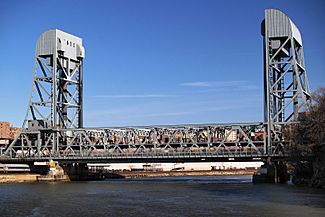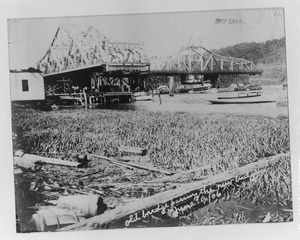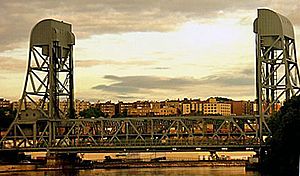Broadway Bridge (Manhattan) facts for kids
Quick facts for kids Broadway Bridge |
|
|---|---|

From the west
|
|
| Coordinates | 40°52′25″N 73°54′40″W / 40.87361°N 73.91111°W |
| Carries | 6 lanes of 3 tracks of IRT Broadway–Seventh Avenue Line ( |
| Crosses | Harlem River Ship Canal |
| Locale | Manhattan, New York City |
| Maintained by | New York City Department of Transportation |
| Characteristics | |
| Design | Double-decked Vertical lift bridge |
| Total length | 558 feet (170 m) |
| Longest span | 304 feet (93 m) |
| Clearance below | 136 feet (41 m) (raised) 24 feet (7.3 m) (lowered) |
| History | |
| Opened | Current span: December 26, 1960 (subway), January 1961 (highway) |
| Statistics | |
| Daily traffic | 36,027 (2016) |
The Broadway Bridge is a special kind of bridge called a lift bridge in New York City. It crosses the Harlem River Ship Canal, which is a waterway that connects different parts of the city. This bridge connects two neighborhoods in Manhattan: Inwood and Marble Hill.
What makes the Broadway Bridge unique is that it has two levels, or "decks." The bottom deck carries Broadway, a major road that is also known as U.S. Route 9. The top deck is for the New York City Subway's IRT Broadway–Seventh Avenue Line, which is used by the 1 train train.
Before the current bridge was built, there were two other bridges in the same spot. The first one was a swing bridge built in the 1890s. It could swing open to let boats pass. Later, a new double-decker swing bridge was built to make space for the subway. The current Broadway Bridge was built between 1957 and 1962 to replace the second bridge. It can lift its middle section high up, allowing even very tall boats to pass underneath.
Contents
What is the Broadway Bridge?
The Broadway Bridge is a vertical-lift bridge with two decks. It crosses the Harlem River Ship Canal in Manhattan, New York City. The lower deck carries Broadway, also known as U.S. Route 9. The upper deck carries three tracks for the New York City Subway.
Even though the bridge helps connect Manhattan to the Bronx, the entire bridge is actually located within Manhattan. The south end of the bridge is in Inwood. The north end is in Marble Hill, which is now part of the mainland United States. The bridge also goes over the Metro-North Railroad's Hudson Line on its northern side.
How busy is the Broadway Bridge?
The lower level of the bridge is used by several bus routes, including the Bx7, Bx20 and the BxM1 express bus. The subway tracks on the upper level carry the IRT Broadway–Seventh Avenue Line (1 train train). Just north of the bridge, you'll find the Marble Hill–225th Street subway station.
In 2016, about 36,027 vehicles crossed the Broadway Bridge every day. The New York City Department of Transportation (NYCDOT) is in charge of keeping the bridge working and safe. The busiest year for the bridge was 1990, when about 42,555 vehicles crossed it daily.
How big is the Broadway Bridge?
The entire bridge, including its ramps, is about 558 feet (170 m) long. The part that lifts up, called the lift span, is 304 feet (93 m) long. When the bridge is closed, the lift span is about 25 feet (7.6 m) above the water. But when it's open, it can lift up to 136 feet (41 m) high, which is like a 13-story building! This allows tall ships to pass underneath.
The lift span itself is very heavy, weighing about 2,600 short tons (2,300 long tons; 2,400 t). It's held up by tall towers on each end, which are about 160 feet (49 m) tall. Strong wire ropes and counterweights help lift the heavy span. Electric motors in each tower power the lifting process.
The lower deck has two roadways, each about 34 feet (10 m) wide, for cars and trucks. There are also sidewalks on both sides, each about 8 feet (2.4 m) wide, for people to walk. A grassy area or barrier, called a median, separates the two directions of traffic.
History of the Broadway Bridge
Before the Harlem River Ship Canal was built, Marble Hill was actually part of Manhattan Island. The Spuyten Duyvil Creek used to curve around Marble Hill. Early bridges like King's Bridge (built in 1693) and Free Bridge (built in 1759) crossed this creek. These old bridges were quite narrow.
In the late 1800s, people wanted to make a straighter path between the Harlem and Hudson rivers. This led to the creation of the Harlem River Ship Canal, which started being built in 1888. Also, a law was passed in 1890 saying that bridges over the Harlem River needed to be taller or able to open to let boats pass.
The First Broadway Bridge
In 1892, the city decided to build a new bridge to connect Inwood and Marble Hill over the new canal. This bridge would carry Broadway. The city approved the Harlem Ship Canal Bridge in 1893. The bridge was built with its foundations placed in the dry canal bed before the water was let in.
The first Broadway Bridge opened on January 1, 1895. It was a single-deck swing bridge, meaning it could pivot open from the middle. It was about 551 feet (168 m) long and had a roadway of 33.5 feet (10.2 m) with two sidewalks. After the canal fully opened in June 1895, the bridge could swing open for boat traffic.
At first, this bridge connected Manhattan Island to Marble Hill, which was still an island itself. Later, in 1914, the old creek bed was filled in, making Marble Hill part of the mainland.
The Second Broadway Bridge
Around 1900, the city decided to replace the first bridge. This was because the new New York City Subway line needed to cross the Harlem River Ship Canal above Broadway. The original bridge wasn't strong enough for the subway. So, a new, double-deck swing bridge was planned.
The old bridge was moved south along the Harlem River and became the University Heights Bridge, which opened in 1908. The new, second Broadway Bridge was built in its place. It was a double-decker swing bridge. The upper deck carried the subway tracks, and the lower deck had a road for cars and streetcars, plus sidewalks.
Building the new bridge was a big project. The different parts of the bridge were built nearby and then floated into place. The goal was to keep traffic on Broadway flowing as much as possible. The old swing span was replaced with the new one in June 1906. The subway service started using the bridge in January 1907.
By the 1930s, the Broadway Bridge was getting very busy, with about 28,000 vehicles crossing it every day. People started talking about building the Henry Hudson Bridge nearby to help with the traffic. The Henry Hudson Bridge opened in 1936, which helped ease some of the congestion.
In 1949, officials suggested building a new lift bridge to replace the second Broadway Bridge. The old swing bridge's three lanes were no longer enough for modern traffic. A lift bridge would also provide more space for boats to pass underneath. In 1956, the bridge was damaged by a fire, which made the need for a new bridge even more urgent. The swing bridge was closed to tall boats in 1957 because it was difficult to close properly.
The Current Broadway Bridge
Work on the current lift bridge began in February 1958. It cost about $13.4 million. The new lift span was built first, which is unusual for lift bridges, because the old bridge was so heavily used. The goal was to interrupt subway traffic as little as possible.
In December 1960, the old bridge was closed to cars, but the subway still ran on it. Then, for three days around Christmas, subway service was stopped to install the new lift span. High winds delayed the installation by one day. Subway service and pedestrian crossings started again on December 26, 1960. The new lift bridge opened to cars in January 1961. It was closed again briefly in July 1961 to install the lifting machinery and rebuild the roads leading to it. By November 1963, all the work was finished.
In 1971, there was a proposal to add tolls to the Broadway Bridge and other free bridges in New York City. This would have meant paying to cross the bridge, but the idea was stopped in 1977.
The NYCDOT has done some smaller repairs on the Broadway Bridge. In 2003, they spent $10 million to fix the deck and protect the steel beams. In 2018, plans were announced to improve how people can walk and bike across the bridge, including adding bike lanes by 2021.
Images for kids
See also
 In Spanish: Puente de Broadway para niños
In Spanish: Puente de Broadway para niños




